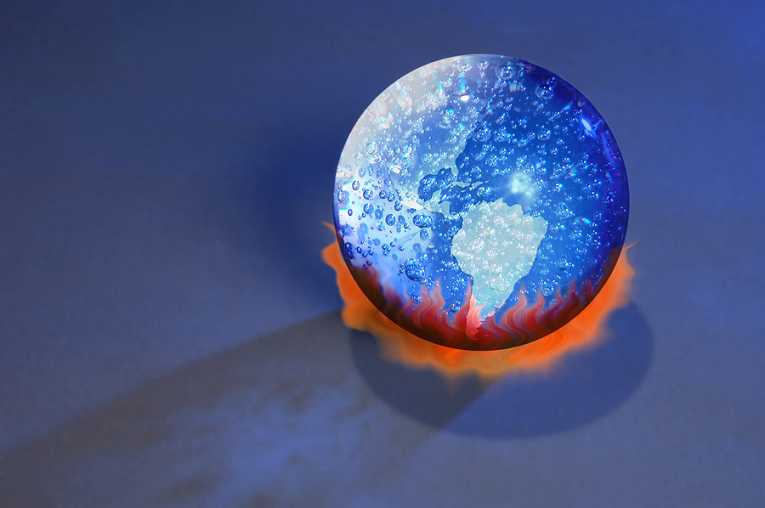Even as residents of New York and Vermont finish are sweeping up the flotsam and jetsam from Irene's recent visit, today Texas is reaping the flip-side of a tempestuous year. Raging fires are destroying homes across the state, capping a record-breaking drought that has seen soil turned to dust, and crops fail. For weather-battered Americans, it seems the climate question that just won't go away. Is this year of relentless storm, snow, flood and fire what climate change looks like, when its up-close and personal?
Of course, when it comes to extreme weather events, the nature vs nurture debate on their origins have become as politicized as the issue of climate change itself. For those who see looming global warming as the paramount threat to the globe, there is a tendency to ascribe man's nurturing hand - through our ever-rising emissions of greenhouse gases - as being behind all recent weather calamities.
Freakish and cruel, or the new normal?
Equally, many in the climate skeptical camp are quick to invoke natural variability as the one-and-only cause. Nature has always been freakish and cruel, and recent events are just a bad run of luck, from their point-of-view. The reality of what is happening in the climate system is, as might be expected, a lot more complicated than either of these simplistic positions would suggest. And the influence of climate change behind the scenes of extreme weather patterns is very much dependent on the weather event being looked at.
Take the drought gripping southern states, and particularly Texas, at the moment. The firestorms being whipped up there come on the heels of Tropical Storm Lee, which pulled strong winds behind it as it slid past Texas. Over 500 homes have now been destroyed in the largest of 60 infernos - the Bastrop fire - taking the total homes lost close to 50,000 since last year.
But droughts have always been part of the rhythm of weather in Texas, with droughts showing up repeatedly in tree-rings dating back thousands of years. The main controlling factor is a weather cycle in the Pacific, one that has been with the world since well before man started tinkering with the climate - the split personality of La Nina/ El Nino. A strong La Nina, with cool waters in the central Pacific, often produces droughts in the southern US. The world is only just emerging from just a strong La Nina, so a drought is to be expected.
Drip-drip of global warming
However, global warming isn't seen by scientists as a powerful force that sweeps all the normal swings and weather patterns away. Instead it's a slow background increase in temperatures, averaged out over the whole globe. It is a little like the drip-drip of a leaky faucet into a bath that is home to a child, restlessly sloshing about. The waves splashing around are what grabs your attention - but almost imperceptibly, those waves are getting higher and higher.
And recent research has confirmed that the 2010-11 Texas drought is the worst recorded over 12 months since records began in 1895. Study author, Nielsen-Gammon, said 'These statistics rank the current drought as the most severe one-year drought ever for Texas. Never before has so little rain been recorded prior to and during the primary growing season for crops, plants and warm-season grasses.'
Additionally, climate models do point to a marked increased in temperatures for the Lone Star state as the globe heats up. Already temperatures are up by two degrees Fahrenheit over the last three decades. Nielsen-Gammon says that climate models suggest that 'by the middle of the century, it should be another two to three degrees warmer, give or take.'
Hurricanes to get angrier?
As for Irene, for all the destruction wrought and lives lost, many have pointed to the comparatively limited damage suffered as evidence of climate change hyperbole. But that is more a reflection of a whipped-up media hysteria, than any flaws with tracking such notoriously unpredictable phenomenon. While scientist may struggle to agree on whether there is a discernible pattern of increased hurricane activity in the historical records, most are agreed that global warming will make hurricanes bigger and wetter.
In a recent press release, the Union of Concerned scientists stated that global warming was likely to make the damage from hurricanes worse on three levels. Firstly, with sea-levels remorselessly rising, storm surges from hurricanes will reach further, and be more destructive. Secondly, with warmer air temperatures, rainfall rates near the heart of the hurricanes of 2100 will be 20% higher - increasing the potential for flooding. There has already been a 20% increase in rainfall rates for the top 1% of storms since 1958.
And lastly, the maximum wind speeds flowing around hurricanes could be up by as much as 11%. over the same time period. So while hurricane numbers may, or may not, be increasing in numbers, the destructive potential of them looks most likely to. If you take a step back, to look at the bigger picture, by tracking the economic damage from extreme weather events, including hurricanes, and there is evidence to bear this out.
Packing more disasters per decade
The NOAA has kept track of the top havoc-wreaking weather disasters - causing more than a billion dollars of damage - since the 1980s. And those numbers appear to be heading in one direction only. From 1981 until 1990, 13 such disasters were recorded. In the ten years since 1991, that tally leaped to 34. And the figure for the last decade is even higher - at 49. And that number excludes the record-breaking 10 billion-plus disasters for just the first 8 months of this year.
So while climate change isn't driving weather extremes, it may well be a factor making those extremes more catastrophic. If that fat lady of climate havoc isn't yet singing, she's certainly making a lot of noise clearing her throat.
Top Image Credit: Climate change or is it a natural cycle? © Gino Santa Maria










